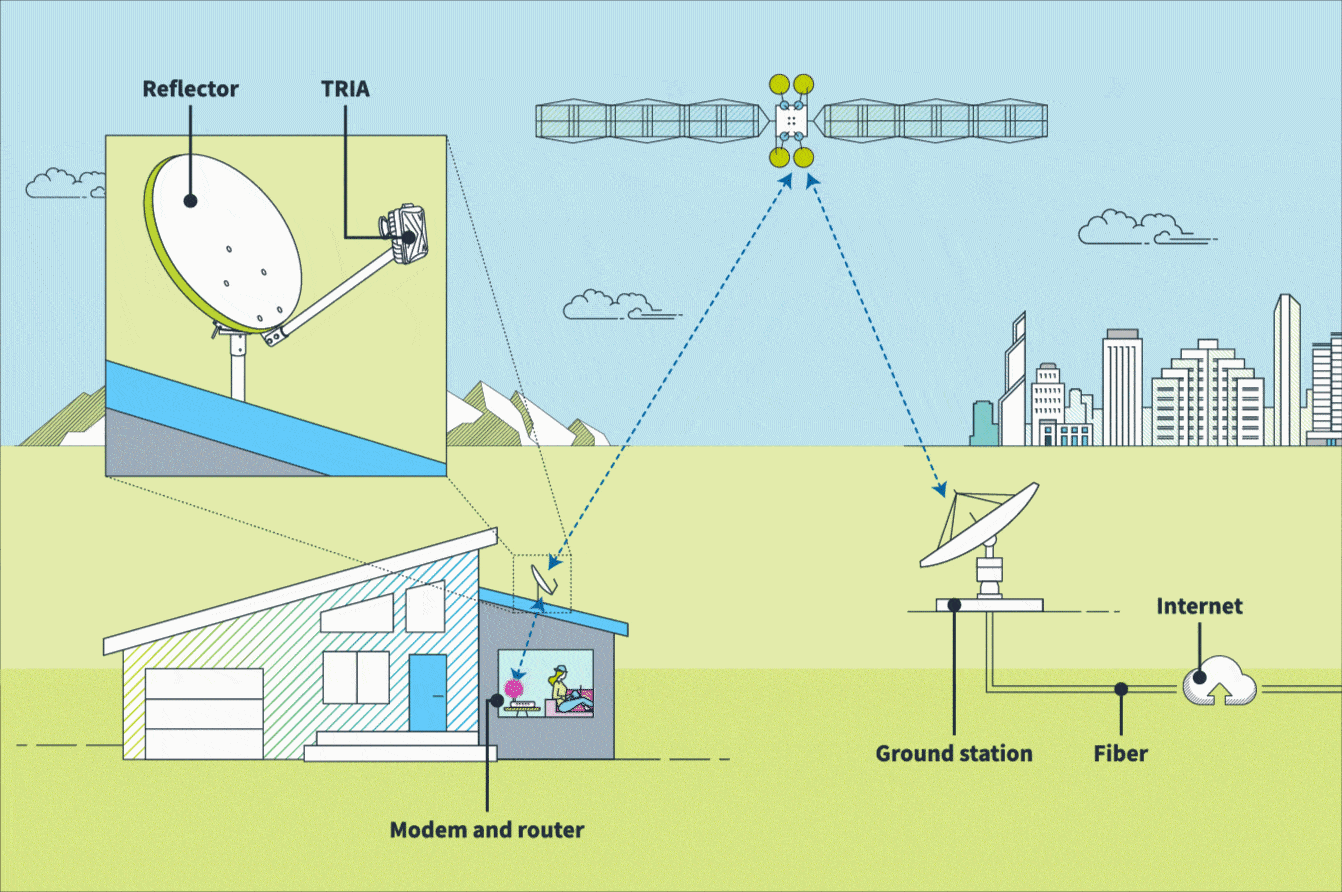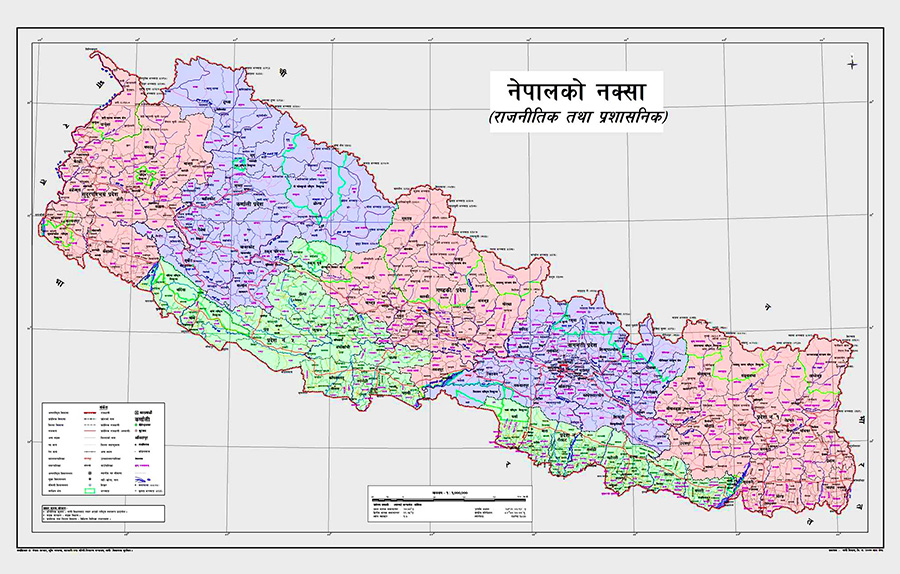
Kacific Satellites, in collaboration with Space Link and Everest Link, has officially inaugurated its Ka-band-based broadband satellite internet service in Nepal. At the launch event held yesterday in Kathmandu, the company officially kicked off its operation in Nepal.
What is satellite internet?
Unlike your typical fiber-based or wireless internet, satellite internet is a bit different. Simply put, its entire process starts with an ISP (Internet Service Provider) sending a geostationary satellite into space that orbits the Earth. The satellite is responsible for transmitting signals to and from the end-user and the “Earth Station”.
Here, the Earth station (or ground station, or gateway) is essentially what delivers internet radio signals to the satellite, which it then forwards to the local modem.

And to receive signals sent by satellite, a receiver dish or a VSAT (Very Small Aperture Terminal) antenna is installed at a location with a clear view of the sky. That’s quite the oversimplification, but I hope you get the idea.
- Also Read:
This is mostly ideal for rural or some geologically complex areas where fiber or dial-up internet is inaccessible. That unavailability may be due to the complicated logistics to expand fiber services, unfavorable economies of scale, or some other reasons entirely.

Regardless, the arrival of satellite internet service in Nepal is quite a significant achievement. That’s because now, the digitally unserved or underserved communities of the country—especially the Himalayan region—will finally have access to the wonders of the internet.
What is Kacific Satellites?
Kacific Satellites is a global broadband satellite operator that currently serves a total of 25 countries in South East Asia and the Pacific territory through 56 satellite spot beams. It is also the largest Ka-band operator in the said region. The company launched its first Ka-band geostationary high throughput satellite (HTS) in December 2019, called “Kacific1”.
Ka-band (or KA band, or Kₐ band, or K-above) defines frequencies in the range of 26.5 – 40 GHz that are used for satellite communication. Here in Nepal, NTA (Nepal Telecommunications Authority) approved the use of the Ka-band spectrum (19.7 – 21.2 GHz downlink, 29.5 – 31 GHz uplink) for satellite internet in March 2021.

So with the foundation set, Kacific Satellites has been testing on setting up a Ka-band terminal in Nepal for quite some time now. But mind you that an international satellite internet provider can’t directly offer its services to the end-user. According to the existing Nepali regulation, it has to route through an NSP (Network Service Provider) and an ISP (Internet Service Provider).
The legal route
In this case, Space Link (NSP) acquired the license for the use of the Ka-band spectrum in March of last year. And to offer Kacific’s satellite internet services in Nepal, it has teamed up with Everest Link (ISP) since a licensed NSP isn’t allowed to provide internet services to the end customer either.
However, Kacific clarified that other ISP or NSPs could also collaborate with the company to extend its services in Nepal if required.

And in December 2021, the company successfully tested a Ka-band terminal in Nepal where it achieved 80 Mbps download and 16 Mbps upload speed. The company has since completed the final stages of testing, and has thus commercially rolled out its services in Nepal. Kacific also conducted a live video feed demo and speed test demo of the Gigstarter 10 User plan during the event, with the following results:
- Download: 59.79 Mbps
- Upload: 9.28 Mbps
- Ping: 659 ms
What’s it gonna cost?
Brace yourselves. While satellite internet’s accessibility is no match for fiber-based internet, that does come at a price. Quite literally. Space Link currently has the following seven subscription tiers for its satellite internet services in Nepal:
| Download speed | Upload speed | Monthly cost | One-time terminal fee | |
| Gigstarter | ||||
| Simple | 3 Mbps | 3 Mbps | Rs. 17,610 | Rs. 88,140 |
| Everyday | 15 Mbps | 10 Mbps | Rs. 25,415 | |
| 4 User | 30 Mbps | 10 Mbps | Rs. 31,950 | |
| 7 User | 50 Mbps | 15 Mbps | Rs. 75,034 | Rs. 159,100 Rs. 88,140 (offer price) |
| 10 User | 60 Mbps | 20 Mbps | Rs. 108,921 | |
| 25 User | 70 Mbps | 20 Mbps | Rs. 278,353 | |
| 60 User | 100 Mbps | 20 Mbps | Rs. 550,655 | Free |
Note: The aforementioned prices are inclusive of VAT. FUP is applicable to all plans.
Apart from the monthly fee, its one-time installation cost is quite staggering too. The 1.2 meters satellite dish alone costs Rs. 88,140 for the Simple to 4 User plan. While the VSAT terminal is free of charge on the top-end Gigstarter 60 User package, it costs Rs. 159,100 for the remaining plans. But the company is currently offering it for Rs. 88,140.
According to Kacific, this discounted rate will be applicable to a handful of customers on a first-come-first-serve basis. Then there’s the charge for the MDM2010 satellite modem, whereas transportation and other tertiary costs are to be incurred by the end customer too.
- Also Read:
Likewise, the satellite dish is also non-returnable. You do get a 1-year warranty but that’s it. That means, in case you’re unsatisfied with the service, you can’t return the dish and get a refund. Kacific did mention that a buyback program of sorts was being discussed internally, but we have no way to tell if and when that program will actually come into action as of now.
Kacific satellite internet in Nepal: Final words
So it’s pretty clear that satellite internet service from Kacific and Space Link is out of reach of many Nepali households. Instead, it’s mostly suited for government offices, hospitals, communities, corporations and business houses, and such. Then again, satellite internet (by its very nature) is expensive compared to fiber or dial-up internet. To minimize the cost burden to a certain degree, one can enroll in the Kacific Authorized Distributor (KAD) program.
This is basically a referral program where individuals or businesses can earn up to Rs. 45,000 by signing up a new customer. But their responsibility also includes installing network equipment to the customer’s location and making sure that the customer renews their subscription.
Despite all this, Kacific has finally enabled high-speed internet services to the remote, geographically challenged region of Nepal. According to NTA’s latest MIS report (April – May 2022), the internet penetration rate in Nepal is abysmally low at just 38%. Even though 93% of the population are covered by cellular network.
So satellite internet is a crucial infrastructure to introduce internet to remote areas of the country. Not just this, it can also play a critical role in terms of establishing communication during natural disasters like earthquakes, landslides, and floods. Kacific also offers enterprise backup solutions where financial institutions, hospitals, etc. can switch to satellite internet for immediate connection in case their existing fiber-based network fails.
- Meanwhile, check out our picks for the best mid-range smartwatches
















![Best Ultrabooks To Buy in Nepal 2024 [Updated] Best Ultrabook Laptops in Nepal 2023 - June Update](https://cdn.gadgetbytenepal.com/wp-content/uploads/2023/04/Best-Ultrabook-Laptops-in-Nepal-2023-June-Update.jpg)
![Best Gaming Laptops in Nepal 2024 [Updated] Best Gaming Laptops in Nepal 2023 - June Update](https://cdn.gadgetbytenepal.com/wp-content/uploads/2023/04/Best-Gaming-Laptops-in-Nepal-2023-June-Update.jpg)


![Best Mobile Phones Under Rs. 15,000 in Nepal [Updated] Best Phones Under 15000 in Nepal 2024 Budget Smartphones Cheap Affordable](https://cdn.gadgetbytenepal.com/wp-content/uploads/2024/03/Best-Phones-Under-15000-in-Nepal-2024.jpg)
![Best Mobile Phones Under Rs. 20,000 in Nepal [Updated] Best Mobile Phones Under NPR 20000 in Nepal 2023 Updated Samsung Xiaomi Redmi POCO Realme Narzo Benco](https://cdn.gadgetbytenepal.com/wp-content/uploads/2024/01/Best-Phones-Under-20000-in-Nepal-2024.jpg)
![Best Mobile Phones Under Rs. 30,000 in Nepal [Updated]](https://cdn.gadgetbytenepal.com/wp-content/uploads/2023/12/Best-Phones-Under-30000-in-Nepal-2024.jpg)
![Best Mobile Phones Under Rs. 40,000 in Nepal [Updated] Best Phones Under 40000 in Nepal 2024 Smartphones Mobile Midrange](https://cdn.gadgetbytenepal.com/wp-content/uploads/2024/02/Best-Phones-Under-40000-in-Nepal-2024.jpg)
![Best Mobile Phones Under Rs. 50,000 in Nepal [Updated] Best Phones Under 50000 in Nepal 2024 Smartphones Midrange](https://cdn.gadgetbytenepal.com/wp-content/uploads/2024/02/Best-Phones-Under-50000-in-Nepal-2024.jpg)
![Best Flagship Smartphones To Buy In Nepal [Updated] Best Smartphones in Nepal 2024 Flagship Premium Samsung Apple iPhone Xiaomi OnePlus Honor](https://cdn.gadgetbytenepal.com/wp-content/uploads/2023/09/Best-Smartphones-in-Nepal-2024.jpg)